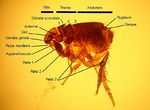|
|
| (29 intermediate revisions by 3 users not shown) |
| Line 1: |
Line 1: |
| − | {{OpenPagesTop}}
| + | [[Image:Cat flea.jpg|thumb|right|150px|Cat Flea - Andy Brookes BS - Wikimedia Commons]] |
| − | {{Taxobox
| + | *Most common flea on both cats and dogs |
| − | |name = ''Ctenocephalides felis
| |
| − | |kingdom =
| |
| − | |phylum =
| |
| − | |class = [[:Category:Insecta|Insecta]]
| |
| − | |sub-class =
| |
| − | |order = [[Siphonaptera]]
| |
| − | |super-family =
| |
| − | |family = Pulicidae
| |
| − | |sub-family =
| |
| − | |genus =
| |
| − | |species = ''Ctenocephalides felis
| |
| − | }}
| |
| − | [[Image:Cat flea.jpg|thumb|right|150px|Cat Flea - August La Roux 2007, Wikimedia Commons]] | |
| | | | |
| − | Also known as: '''''Cat flea
| + | *Most important flea in veterinary medicine |
| | | | |
| − | ''Ctenocephalides felis'' is the most commonly seen flea on both cats and dogs, and is of the order [[Siphonaptera]]. It is also an important intermediate host in the parasite [[Dipylidium caninum|''Dipylidium caninum'']]. | + | *Commonly called the 'cat flea' |
| | | | |
| − | ==Hosts==
| + | *Can bite humans and other animals |
| − | Cats, dogs, and humans.
| |
| | | | |
| − | ==Identification==
| + | *Both genal and pronotal commbs present |
| − | The adults are dark-brown, and have fascicles and laciniae adapted for piercing skin and sucking blood. They have large legs, containing resilin, adapted for jumping, and are laterally flattened, so they can easily move through the hair of the hosts. The adults have rows of spines, known as 'combs' or 'ctenidia', which are very important in the identification process. The first genal spine is 0.75 times the length of the second
| |
| | | | |
| − | See [[Flea Structure|general flea structure]].
| + | *Similar length genal combs |
| | | | |
| − | ==Life Cycle==
| + | *The first genal spine is 0.75 times the length of the second |
| − | The female lays eggs directly on the host. These then fall off into the environment, and hatch into larvae. The eggs are strong and very resistant to environmental changes. The larvae undergo two further moults, before pupating within the cocoon (produced by the larvae.) | |
| | | | |
| − | When the parasite is fully developed the adults emerge from the pupae, but remain within the cocoon. They will hatch out of the pupae when stimulated by movement, or heat. Overall, most of the life cycle is spent away from the host.
| + | *Sloping nose |
| | | | |
| − | See [[Flea Life Cycle|general flea life cycle]].
| + | *6 notches bearing setae on the dorsal border of the hind tibia |
| − | | + | [[Category:Cat]][[Category:Dog]] |
| − | {{Learning
| |
| − | |flashcards = [[Fleas_Flashcards|Fleas Flashcards]]
| |
| − | |literature search = [http://www.cabdirect.org/search.html?rowId=1&options1=AND&q1=title%3A%28%22Ctenocephalides+felis%22%29+&occuring1=freetext&rowId=2&options2=AND&q2=&occuring2=freetext&rowId=3&options3=AND&q3=&occuring3=freetext&publishedstart=2000&publishedend=yyyy&calendarInput=yyyy-mm-dd&la=any&it=any&show=all&x=51&y=11 ''Ctenocephalides felis'' publications since 2000]
| |
| − | |Vetstream = [https://www.vetstream.com/canis/search?s=flea Fleas]
| |
| − | }}
| |
| − | | |
| − | | |
| − | {{OpenPages}}
| |
| − | | |
| − | [[Category:Cat Parasites]][[Category:Dog Parasites]] | |
| | [[Category:Fleas]] | | [[Category:Fleas]] |
| − | | + | [[Category:To_Do_-_Parasites]] |
| − | [[Category:Expert_Review]] | |
